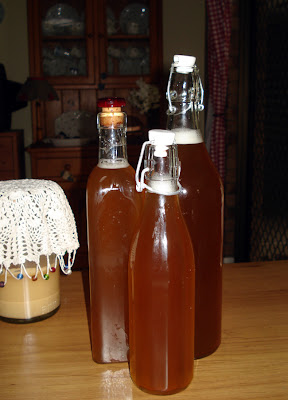Well ladies and gentlemen, I've made my own liquid soap, tested it for a few weeks, and now I'm happy to recommend it to you. I've tried several versions of homemade grated soap, I added glycerin to it, boiled it, and tried every which way but it was always horrible to use. Slimy, ugh. What I was after was a liquid soap that could be easily poured from a bottle, that I could use for washing up, as a shampoo, stain remover, handwash, for washing pure wool by hand, and as a horticultural soap. I have all those things, and more - Hanno used it to wash Quince, one of our chickens.
I used this recipe and tutorial and found it to be a very good reference. The only thing I changed was the sunflower oil - I used rice bran oil because I have a lot of it. This soap is made in a crockpot and you'll need a stick blender. My finished product turned out darker than I expected but I think I added too much borax and over processed it at the end. I won't repeat the tutorial here, I'll just add some of my photos and comment on what I did. Be guided by David's tutorial for the recipe and the method.
Making liquid soap is more difficult and takes more time than cold pressed soap. It uses a different form of lye - Potassium Hydroxide. You'll have to find a soapmaker near you who sells this because, at least in Australia, it cannot be sent through the post. You cannot buy this stuff at the supermarket or hardware.
When you have assembled all your ingredients, make sure you remember all your safety precautions for making soap - they apply here as well.
When you add water to the potassium hydroxide, it makes a noise. Like groaning! Don't be alarmed, it's normal.
When you have everything mixed together and you've stirred for what seems like hours, you cook the mixture in the crockpot. It turns the mix into a big batch of goo.
When you add water to the potassium hydroxide, it makes a noise. Like groaning! Don't be alarmed, it's normal.
When you have everything mixed together and you've stirred for what seems like hours, you cook the mixture in the crockpot. It turns the mix into a big batch of goo.
The entire process takes a long time so it's good to know that when the paste has been diluted (stage 6 of the tutorial), you can leave it and continue on the following day.

The photo above shows the solution being tested for clarity at stage 5 of the online process. Notice how clear it is. The finished product isn't as clear as this.

This is my soap being sequestered - stage 9 of the process.
Making liquid soap is not something you should try if you haven't made some other kind of soap. I found it complicated and time consuming and when I finished I thought I wouldn't make it again. But since then I've used it and I really love it. It's a multi-purpose product, it does as good a job as detergent when I'm washing up - but it doesn't contain anything harmful, like petro-chemicals. The saponification process turns it into a healthy soap that can be used for a wide range of household tasks as well as personal hygiene. This soap, although it takes a long time to make, is definitely part of my homemaker's armoury now. I'm doing to include it in some gifts as well. Tomorrow I'll write about washing up and using the soap for other projects in the home and garden.
Sharon has started a crochet-along over at the forum. If you've wanted to learn how to crochet, or would like to crochet a jug cover, similar to those I use for my ginger beer and sourdough, click here for Sharon's instructions. She is an experienced crocheter so if you have any problems, simply post to the thread and Sharon, or one of the other ladies, will help you.
Making liquid soap is not something you should try if you haven't made some other kind of soap. I found it complicated and time consuming and when I finished I thought I wouldn't make it again. But since then I've used it and I really love it. It's a multi-purpose product, it does as good a job as detergent when I'm washing up - but it doesn't contain anything harmful, like petro-chemicals. The saponification process turns it into a healthy soap that can be used for a wide range of household tasks as well as personal hygiene. This soap, although it takes a long time to make, is definitely part of my homemaker's armoury now. I'm doing to include it in some gifts as well. Tomorrow I'll write about washing up and using the soap for other projects in the home and garden.
Sharon has started a crochet-along over at the forum. If you've wanted to learn how to crochet, or would like to crochet a jug cover, similar to those I use for my ginger beer and sourdough, click here for Sharon's instructions. She is an experienced crocheter so if you have any problems, simply post to the thread and Sharon, or one of the other ladies, will help you.




